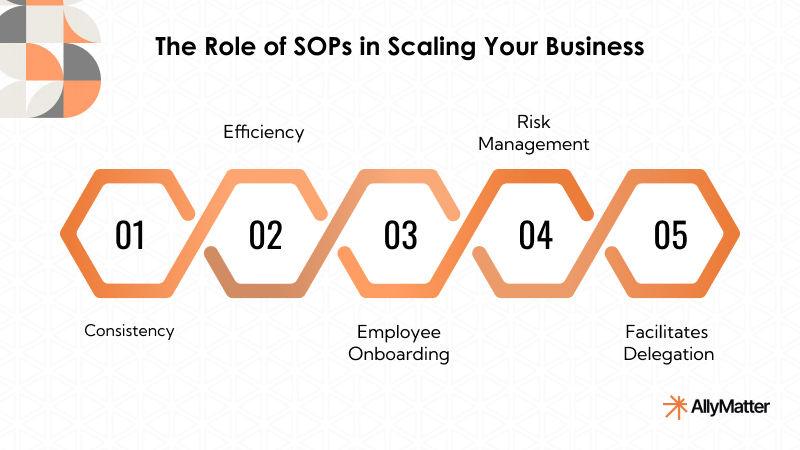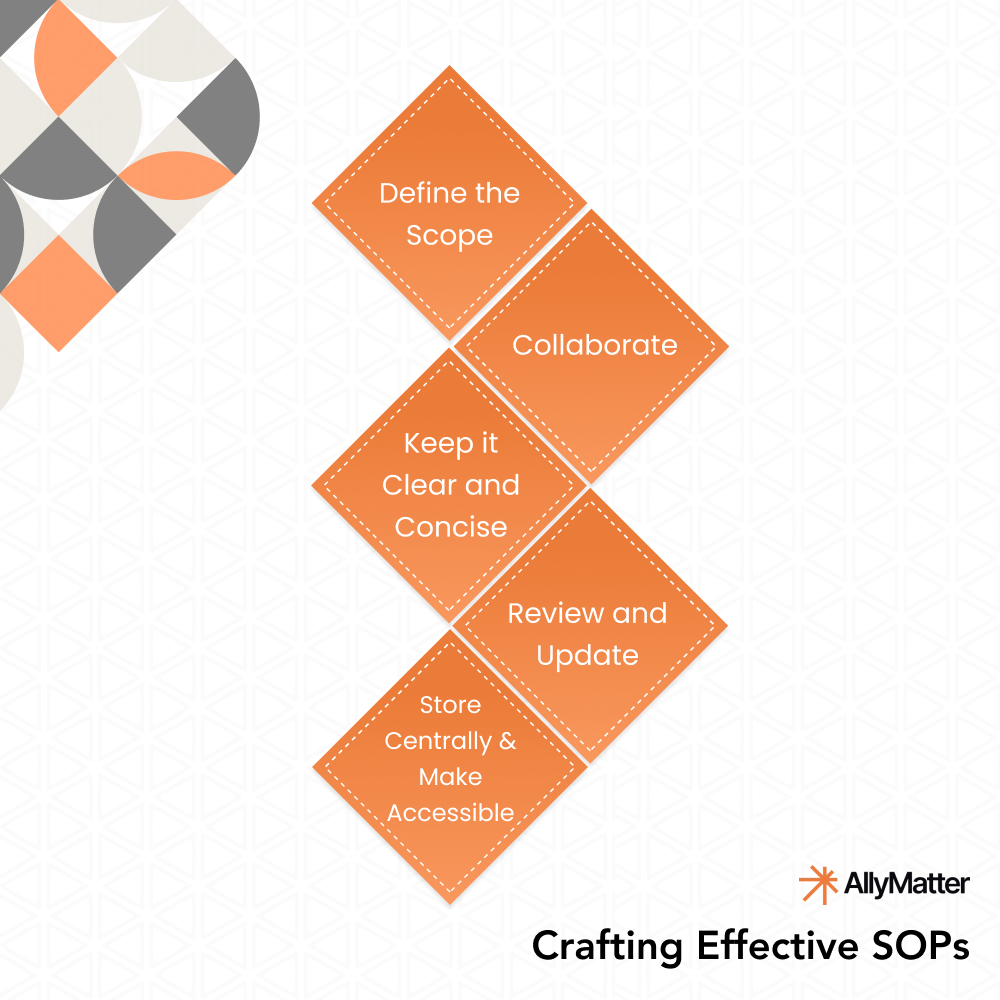Scaling a business is both an exciting and daunting task. As demand grows, the complexities in operations, management, and services also increase. However, one of the most underrated yet powerful tools to navigate this labyrinth of growth is the Standard Operating Procedure (SOP) documentation.
What is SOP documentation?
Standard Operating Procedure documentation is essentially a written, step-by-step instruction manual on how to execute a specific task or operation within a company. It streamlines complex tasks, ensures consistency across operations, and equips new employees with clear directives.
The role of SOPs in scaling your business

- Consistency: As a business grows, maintaining the same level of service or product quality can become a challenge. SOPs ensure that all tasks, regardless of who performs them, are done in a consistent manner. This uniformity assures customers of the same high-quality experience, strengthening brand loyalty.
- Efficiency: Well-documented procedures can significantly reduce the time spent on training and task execution. Instead of relying on memory or improvisation, employees can follow a tried-and-true process, thereby speeding up operations and reducing errors.
According to McKinsey research, employees spend nearly 20% of their workweek looking for internal information or tracking down colleagues for help. Well-documented SOPs eliminate this productivity drain by providing immediate access to step-by-step guidance. - Employee onboarding: With a growing business comes the need for more hands on deck. SOPs provide new hires with a clear roadmap of their responsibilities, enabling faster acclimatization to the company culture and operations.
- Risk management: Mistakes can be costly, both in terms of finances and reputation. SOPs minimize human errors by detailing precisely how tasks should be carried out. Moreover, in the event of key personnel departures, the business isn’t left vulnerable; the SOPs ensure continuity.
- Facilitates delegation: For business leaders, delegation becomes crucial as the company grows. SOPs allow leaders to hand over tasks with confidence, knowing the task will be performed according to set standards.
Crafting effective SOPs

Define the scope: Start by identifying which processes need SOPs. Prioritize those that are mission-critical, repetitive, complex, or prone to errors.
Collaborate: Engage teams and individuals who regularly perform the tasks. Their hands-on experience can provide valuable insights that can make the SOP more practical.
Keep it clear and concise: While it’s essential to be detailed, also ensure the document is not overly technical or lengthy. Use simple language, bullet points, diagrams, and flowcharts to enhance readability.
Review and update: Business operations evolve, and so should your SOPs. Regularly revisit and refine them to ensure they remain current and effective.
Store centrally and make accessible: An SOP is of no use if employees can’t find it. Use a central repository, such as a company intranet or a cloud-based system, to store and categorize all SOPs.
Read more: The Power of Building Internal Documentation That Works
Recognizing when your SOPs need documentation
Your growing company needs systematic SOP documentation if:
- New team members ask the same operational questions repeatedly
- Critical processes depend on specific employees who might leave
- You’re experiencing inconsistent results across similar tasks
- Compliance requirements demand standardized procedures
Here is a quick SOP assessment framework. Ask yourself: “If our most experienced team member left tomorrow, could someone else execute this process flawlessly?” If the answer involves phrases like “probably” or “they’d figure it out,” you need documentation.
Digital transformation of SOPs
In this digital age, businesses are moving beyond static Word documents or PDFs. Digital SOP platforms, integrated with videos, augmented reality (AR), and interactive elements, make it easier for employees to understand and engage with the content. Such systems can also offer real-time updates and feedback mechanisms.
Challenges in SOP implementation
While SOPs offer myriad benefits, their implementation isn’t without challenges:
- Resistance to change: Long-standing employees might be resistant to new methods. Address this by showcasing the value SOPs bring to their daily tasks and offering training sessions.
- Over documentation: Avoid the pitfall of creating SOPs for every little task. Focus on processes that genuinely need standardization.
- Ambiguity: Ensure that the SOP doesn’t leave room for interpretation. It should be specific and clear-cut to avoid different interpretations.
AllyMatter: Centralize your SOP documentation for scalable growth
The most effective SOP systems share common characteristics: they’re centralized, easily searchable, and maintain version control. Growing companies often struggle with SOPs scattered across shared drives, wikis, and email threads.
A robust knowledge management platform should offer smart approval workflows to keep procedures current as your business evolves. Look for solutions that provide granular access control, ensuring team members can quickly find the procedures relevant to their roles while maintaining security for sensitive processes.
The goal isn’t just to document procedures – it’s to create a knowledge ecosystem that grows with your company and supports decision-making at every level.
Building your foundation for sustainable growth
In the grand scheme of business growth, Standard Operating Procedure documentation might seem like a minor cog. However, its impact on efficiency, consistency, and scalability is profound. As your business ventures into new territories, encounters novel challenges, and strives to meet increasing demand, SOPs can be the guiding light, ensuring that the essence of your brand and the quality of your service remain unblemished. Embrace them, refine them, and watch them play an instrumental role in your business’s success story.
Ready to transform scattered procedures into organized, accessible SOPs? Join our waitlist to discover how centralized documentation can support your scaling journey.
Common SOP implementation questions
How do we prioritize which processes to document first when resources are limited?
Focus on processes that directly impact customer experience, have compliance implications, or create bottlenecks when performed incorrectly. Document procedures where knowledge transfer currently depends on specific individuals.
What’s the best approach for maintaining SOP accuracy as our business rapidly evolves?
Assign process owners who are responsible for specific SOPs and implement quarterly review cycles. Use approval workflows that automatically flag outdated procedures and establish a feedback system where team members can suggest updates.
How can we ensure team members actually use SOPs instead of relying on informal knowledge sharing?
Integrate SOP usage into performance reviews and training programs. Make procedures easily accessible through search functionality and ensure they’re written in clear, practical language that saves time rather than creating administrative burden.
Should we document every process or focus only on critical procedures?
Start with mission-critical, customer-facing, and compliance-related processes. Avoid over-documentation of simple tasks that team members can intuitively understand. Focus on procedures where consistency and accuracy directly impact business outcomes.
How do we balance detailed documentation with keeping SOPs readable and actionable?
Use visual elements like flowcharts and screenshots where helpful. Break complex procedures into logical steps and include decision points that guide users through different scenarios. Test SOPs with new team members to ensure clarity.


